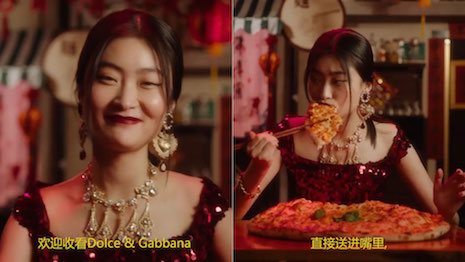 Dolce & Gabbana's China social media video campaign mocked a Chinese woman for not knowing how to use chopsticks to eat pizzas. Image credit: Dolce & Gabbana
Dolce & Gabbana's China social media video campaign mocked a Chinese woman for not knowing how to use chopsticks to eat pizzas. Image credit: Dolce & Gabbana
By Glyn Atwal
Does your brand suck? This is not a question that luxury brand executives often hear in the boardroom.
The initial reaction is to shrug off any suggestion that a luxury brand could possibly not be loved.
Marketing budgets are invested to develop and nurture emotional relationships. And, yes, many luxury brands are indeed loved, which is not only reflected in social media activity but ultimately, the bottom line.
The downside, however, is that brand love can too easily transform to brand hate. The reasons why consumers hate luxury brands vary from poor customer service to ethical or moral transgressions.
The transition from love to hate may evolve over time or be a result of an isolated incident.
The concept of hate is a powerful emotion that encompasses intense feelings from disgust to anger to contempt. This can manifest into varying degrees of negativity from brand rejection to brand revenge.
The case of Dolce & Gabbana (D&G) in China may be an extreme example, but it shows how regular consumers were not only ready to turn against a brand but were also less willing to forgive.
The case of D&G should be a wake-up call for every luxury brand.
Indeed, there have been more recent incidents in which luxury brands have been the target of high-profile consumer boycotts.
Brand executives should not be in denial that their brand can also become a victim of brand hate. This is uncharted territory for many luxury brands, but it also reflects the need to navigate the following pressures which have helped to create a ‘new normal’ of luxury brand management.
 Glyn Atwal is associate professor of marketing management at the Burgundy School of Business
Glyn Atwal is associate professor of marketing management at the Burgundy School of Business
Scrutiny
Luxury brands are likely to come under greater scrutiny compared to non-luxury brands.
The reasons why luxury brands appear to be particularly vulnerable can be attributed to its prestige positioning.
A high-profile brand is more likely to attract the attention of media and pressure groups. And clicks.
Consumers are also expecting standards from luxury brands which represent the pinnacle of excellence. This heightened scrutiny goes beyond product or service performance but encompasses all branding touchpoints.
Belief-driven
Consumers are increasingly aligning their own personal values with those of the luxury brands they buy.
According to 2019 Edelman Trust Barometer Special Report, 64 percent of consumers choose, switch, avoid or boycott a brand based on its stand on societal issues.
Today’s consumer is belief-driven which means that they are willing to reward or punish a luxury brand because of its position on social or political issues. Black Lives Matter is just one of many social causes. Luxury consumers and particularly younger cohorts do care.
Call-out culture
The belief-driven consumer is not afraid to call brands to account.
Consumers are increasingly taking a stand facilitated by the widespread use of social media.
In a Sprout Social US survey, 56 percent of millennials have used social media to “call out” or criticize a business.
Burberry, for example, was outed for incinerating tens of millions of dollars of unsold goods. Hashtag activism has entered the mainstream.
Amplification
Consumers who are often left emotionally outraged by perceived company shortcomings want their feelings to be known by as many people as possible. This type of response can be particularly toxic to brands as it gains momentum on social media.
However, a game changer is how influencers or key opinion leaders (KOLs) are able to reinforce the hate toward the brand.
In the case of D&G in China, Chinese celebrities who enjoy huge followings turned to social media to either criticize or call to boycott the brand.
THE RISK OF luxury brands facing brand hate is very real.
A quick search on social media may reveal a reality check on consumer sentiment.
Of course, some luxury brands are positioned to polarize customer opinion. This does not mean that they have to “suck.”
Luxury executives need to recognize the risk that brand hate will not only distance former customers, but also spread to existing and future customers. This can also have a devastating impact on other stakeholders, namely employees and investors.
It is time to put what can be done to avoid brand hate on the marketing agenda.
Glyn Atwal is associate professor of marketing management at Burgundy School of Business (France). He is co-author of "Luxury Brands in China and India" (Palgrave Macmillan). Reach him at glyn.atwal@bsb-education.com.
